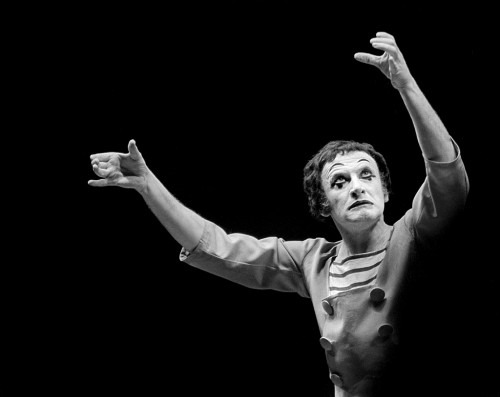 One of the advantages of working for The Ohio University Post and The Athens Messenger was access to press credentials to cover some of the best performers of the time. I was fortunate enough to photograph Marcel Marceau when he performed at Memorial Auditorium on February 16, 1968 (if the negative sleeve is right).
One of the advantages of working for The Ohio University Post and The Athens Messenger was access to press credentials to cover some of the best performers of the time. I was fortunate enough to photograph Marcel Marceau when he performed at Memorial Auditorium on February 16, 1968 (if the negative sleeve is right).
Never saw anyone do more with less
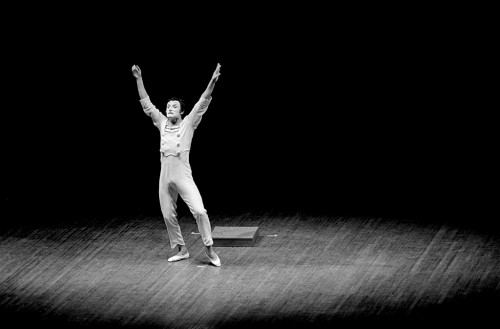 I was impressed with how little it took Simon and Garfunkel to put on their concert, but Marceau required even less equipment. All he needed was a stage and a spotlight to hold an audience spellbound.
I was impressed with how little it took Simon and Garfunkel to put on their concert, but Marceau required even less equipment. All he needed was a stage and a spotlight to hold an audience spellbound.
Show was technically challenging
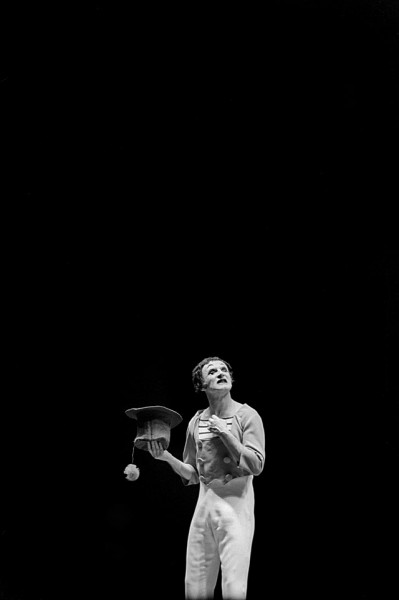 This was a performance where it really paid off to show up early enough to take an incident light reading on the stage before the show began. If I had tried to use a standard reflective light meter, it would have been fooled by the ocean of blackness surrounding Marceau. An incident light meter measures the light falling onto the subject rather than the light reflecting off the subject. That was my preferred method of metering when I could use it. Luckily, I was able to get the spot operator to fire it up long enough for me to get a reading.
This was a performance where it really paid off to show up early enough to take an incident light reading on the stage before the show began. If I had tried to use a standard reflective light meter, it would have been fooled by the ocean of blackness surrounding Marceau. An incident light meter measures the light falling onto the subject rather than the light reflecting off the subject. That was my preferred method of metering when I could use it. Luckily, I was able to get the spot operator to fire it up long enough for me to get a reading.
I’m not sure what’s happening
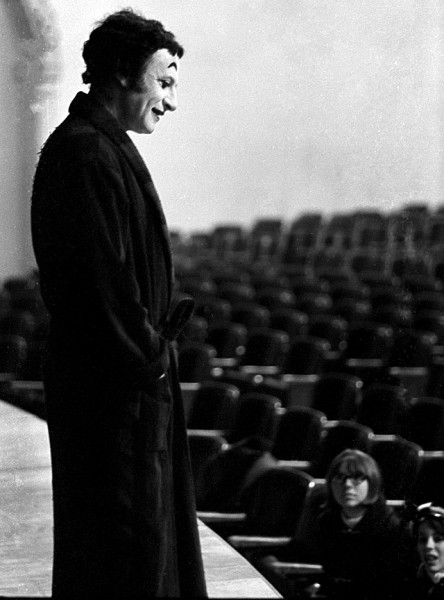 I don’t know if this was taken during a rehearsal, before the show or when. The house was packed for the actual performance, but there was only a handful of people around when I shot this.
I don’t know if this was taken during a rehearsal, before the show or when. The house was packed for the actual performance, but there was only a handful of people around when I shot this.
“White ink drawings on black backgrounds”
 Marceau once said, “I have designed my style pantomimes as white ink drawings on black backgrounds, so that man’s destiny appears as a thread lost in an endless labyrinth. I have tried to shed some gleams of light on the shadow of man startled by his anguish.”
Marceau once said, “I have designed my style pantomimes as white ink drawings on black backgrounds, so that man’s destiny appears as a thread lost in an endless labyrinth. I have tried to shed some gleams of light on the shadow of man startled by his anguish.”
When I looked at these frames, I knew exactly what he was talking about. I’ve never seen anyone who used black space more effectively.
Father killed at Auschwitz
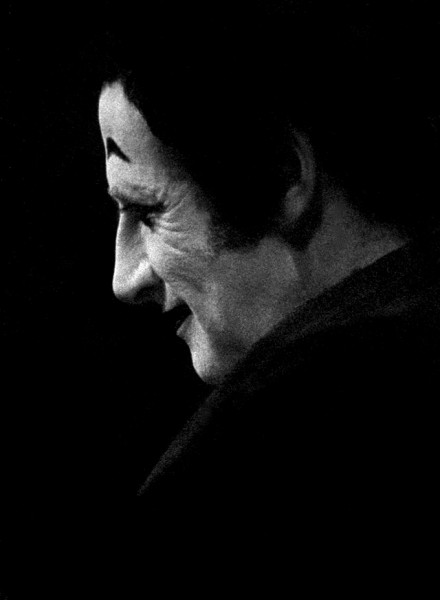 A biography on the IMDb website said that Marceau was born Marcel Mangel on March 22, 1923, in Strasbourg, Alsace, France. At age 5, he was entranced when his mother took him to see a Charlie Chaplin movie; he decided to become a mime. At the beginning of World War II, he had to hide his Jewish origin and changed his name to Marceau. His father was deported to Auschwitz, where he was killed in 1944.
A biography on the IMDb website said that Marceau was born Marcel Mangel on March 22, 1923, in Strasbourg, Alsace, France. At age 5, he was entranced when his mother took him to see a Charlie Chaplin movie; he decided to become a mime. At the beginning of World War II, he had to hide his Jewish origin and changed his name to Marceau. His father was deported to Auschwitz, where he was killed in 1944.
Marceau and his brother, Alain, were in the French underground and helped children escape to neutral Switzerland. He later served as interpreter for the Free France Forces under General Charles de Gaulle.
When he died in 2007, Timothy W. Ryback wrote in The New York Times about Marceau’s concern about the fragility of his art. “Unlike novels or plays or operas, which could be printed, recorded, preserved, the art of mime was a transitory and ephemeral art. It existed only in the moment. And, more unsettling still, essentially in one man, Marcel Marceau,” Ryback said.
Photo gallery of Marcel Marceau
I’m glad I had a chance to see the world’s best-known mime. Click on any photo to make it larger, then click on the left or right side to move through the gallery. By the way, while researching this, I saw a link to “Marcel Marceau quotes.” I figured clicking on it would take me to a blank page. Surprisingly enough, Marceau said, among other things, “Never get a mime talking. He won’t stop.”

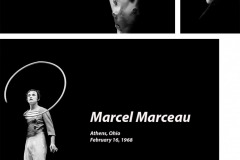
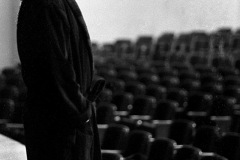
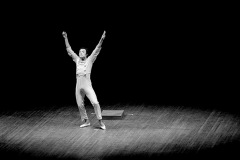
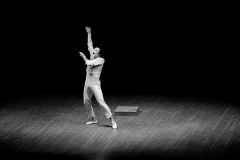
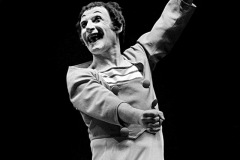
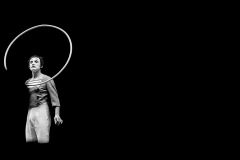
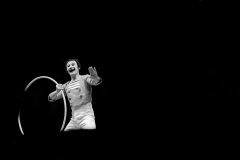
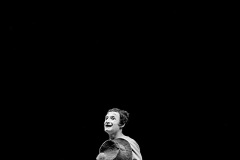
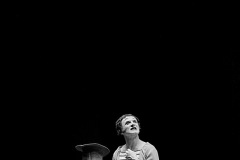
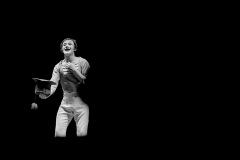
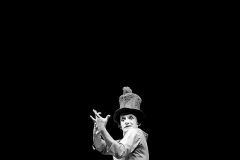
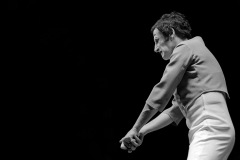
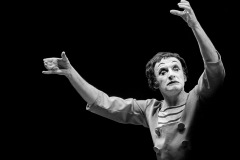
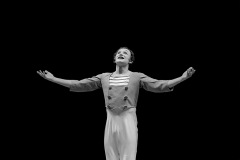
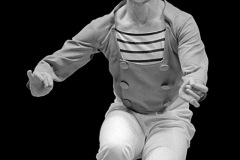
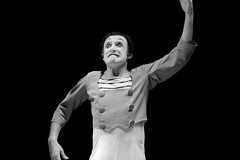
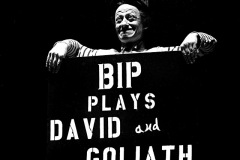
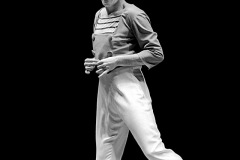
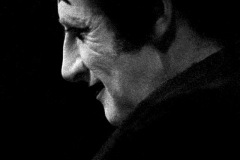
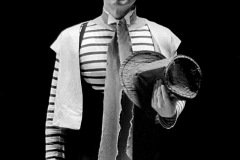

Really nice work Ken. You used negative (black) space extraordinarily well. I really enjoyed studying these photos. Thanks for sharing them.
I remember Marcel from my jr. college days – ’71-’73. He was all the rage and appeared on several TV shows- with all the jokes that went with it. He reminded me of Red Skelton and his mime spots; up until then, Skelton was the only mime I had seen. Marcel was so much more graceful and of course, his performances contained both light and dark comedy and messages. Thanks for sharing.
Russ Rogers left this comment on Facebook. It’s too good not to move over here:
Marcel Marceau has defined what it means to be a mime for generations to come. Maybe he just so thoroughly embodied the Platonic Ideal of what a Master Artist and Mime should be that it just seems like he defines it. Maybe he just perfectly fits the definition that is already there. I’m playing with semantics. Marceau wasn’t just good. He was great. And I never saw Marceau perform live, just in little tastes on television.
Mime is magic when it’s done right. It’s pathetic when its done poorly. There isn’t much room for just so-so mime. There is a LOT of empty space that a performer has to fill in the audience’s imagination. And if they fall short of that goal…well, it’s bad. It’s like a tightrope walker reaching out his foot and finding no rope there. It’s a trapeze artist, flying through the air toward a distracted catcher. “MIME” has such a cultural stigma right now of being a cliche, a sad punchline to a string of jokes. Mimes have become an “ethnic minority” it’s still PC to denigrate in jokes. It just shows that there hasn’t been any artists near Marceau’s stature to demand that mime be respected.
And yet … you can SEE Marceau’s lasting impact. It’s not hard to recognize the body isolation that Mime uses permeating hip-hop dance. Krunking owes more to Marceau as a stylistic influence than it does to Snoop Dogg. Michael Jackson would never have Moonwalked if Marceau hadn’t walked against the wind. “The Artist” would not have been made, or it would not have been a French Film, if not for the influence of Marceau!
Even in your still photos, you can FEEL the skill, the mastery Marcel Marceau had on stage. That is a credit to Marceau as a mime, and to you as a photographer for capturing and sharing that. Thank you.
Thus ends today’s impromptu essay on Marcel Marceau, Mime and pop culture.
:^).
Unfortunately the software would not accept just the above in honor of Marceau.
Ken,
I’m only getting this on Facebook – no longer on email.
Can you update or whatever techies do???
Thanks – am missing my morning message!!!!
Bunny
Oh, how I wish these wonderful photos had been posted sooner! I have a picture book biography of M. Marceau (for children) coming out in September from Porter/Roaring Brook/Macmillan, and we were looking for photos. These are great! But I found another good one, luckily.
Keep them in mind for the second edition.
Sorry I didn’t get them up sooner. They haven’t seen daylight since they were taken back in 1968. Do you have any similar projects in the works from that era?
Who took these pictures ?
I did. Contact me if you would like to reproduce them.